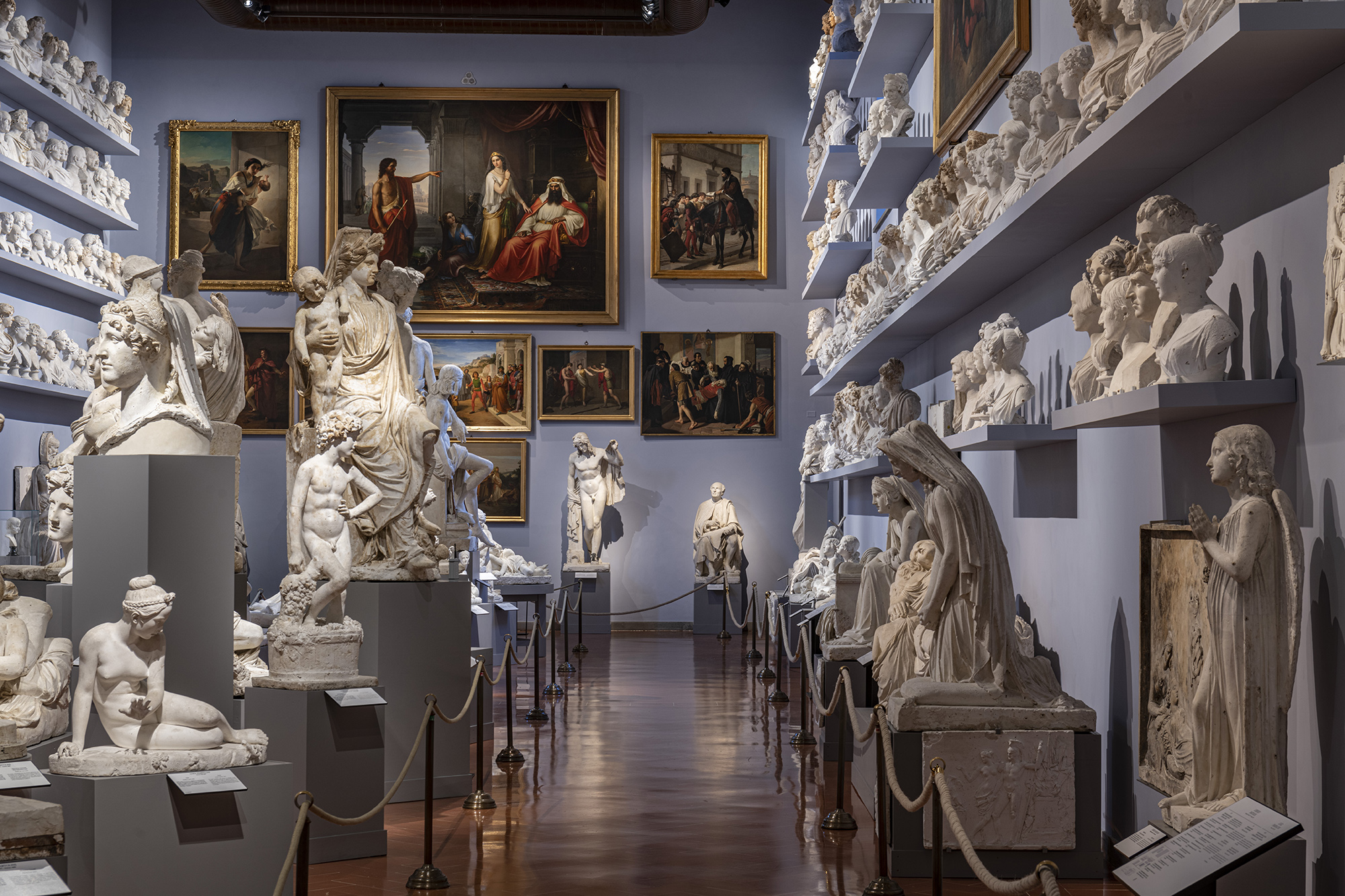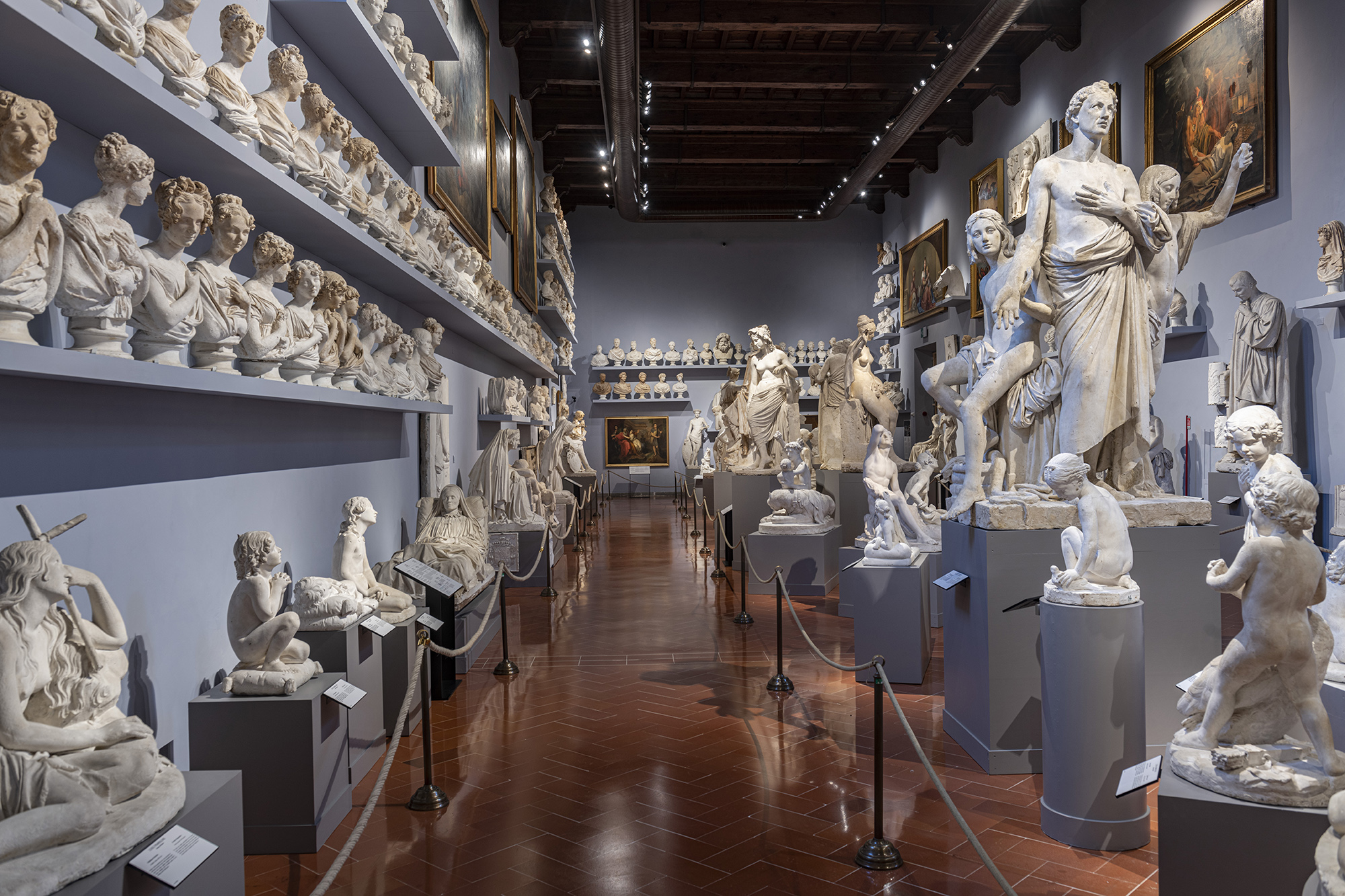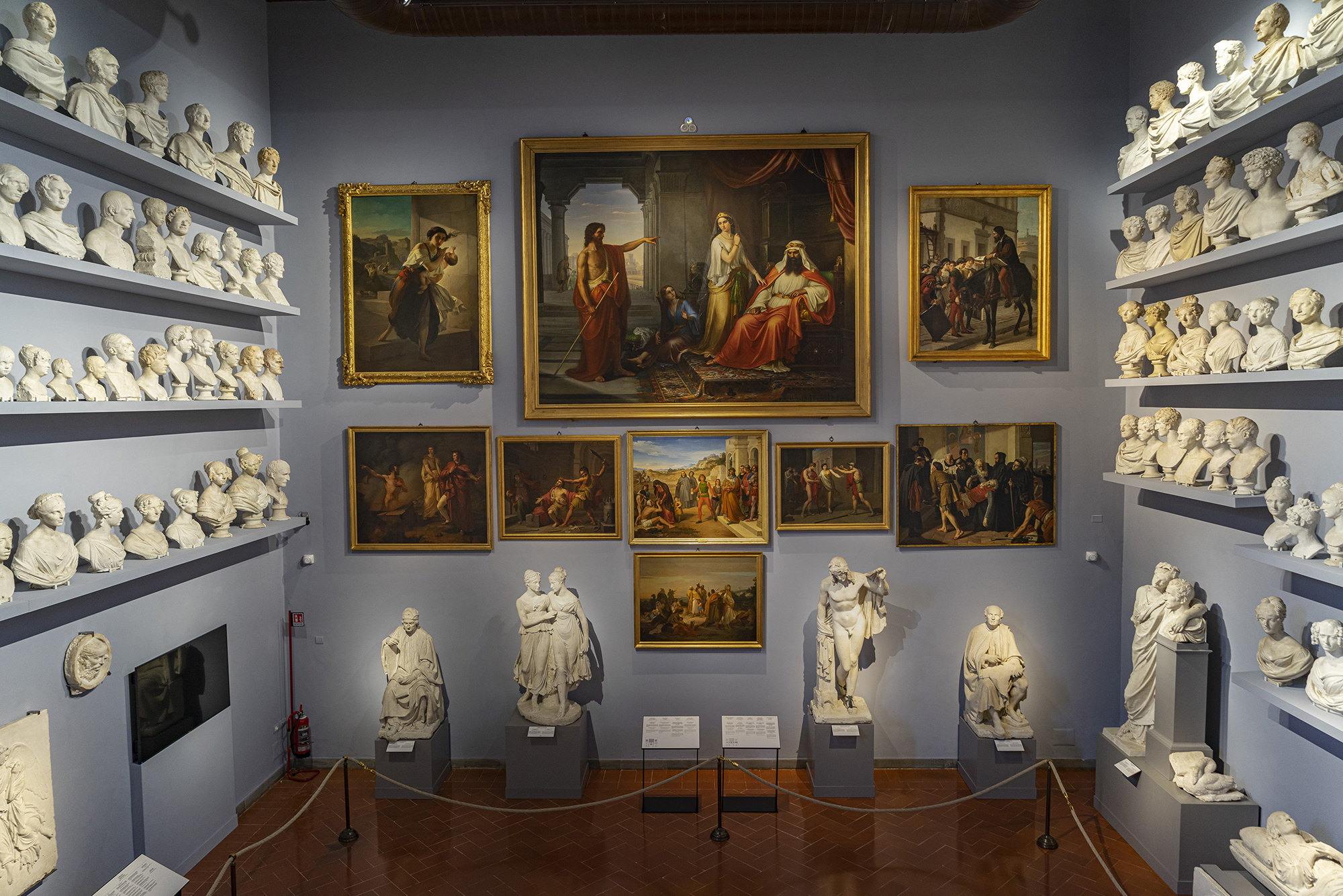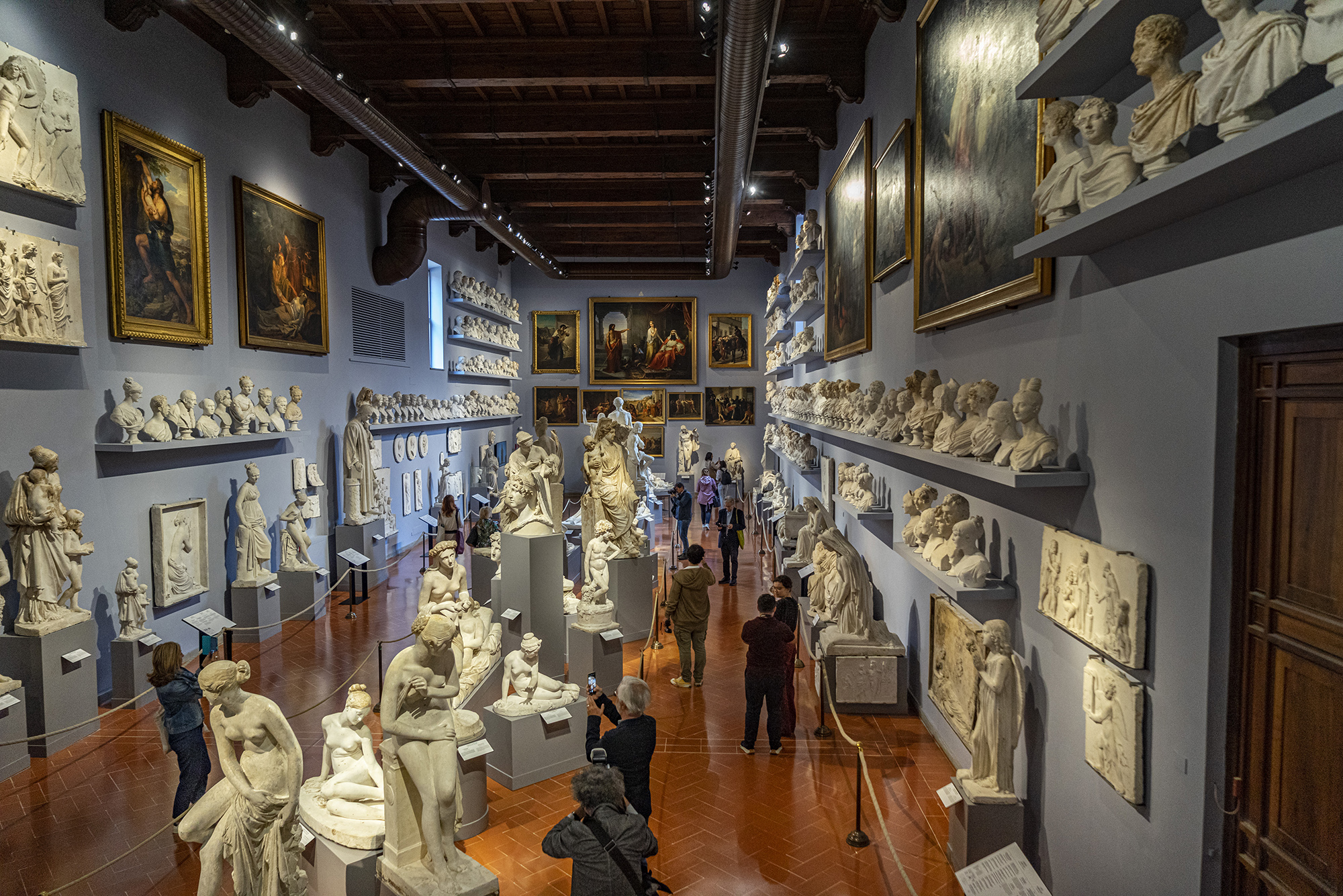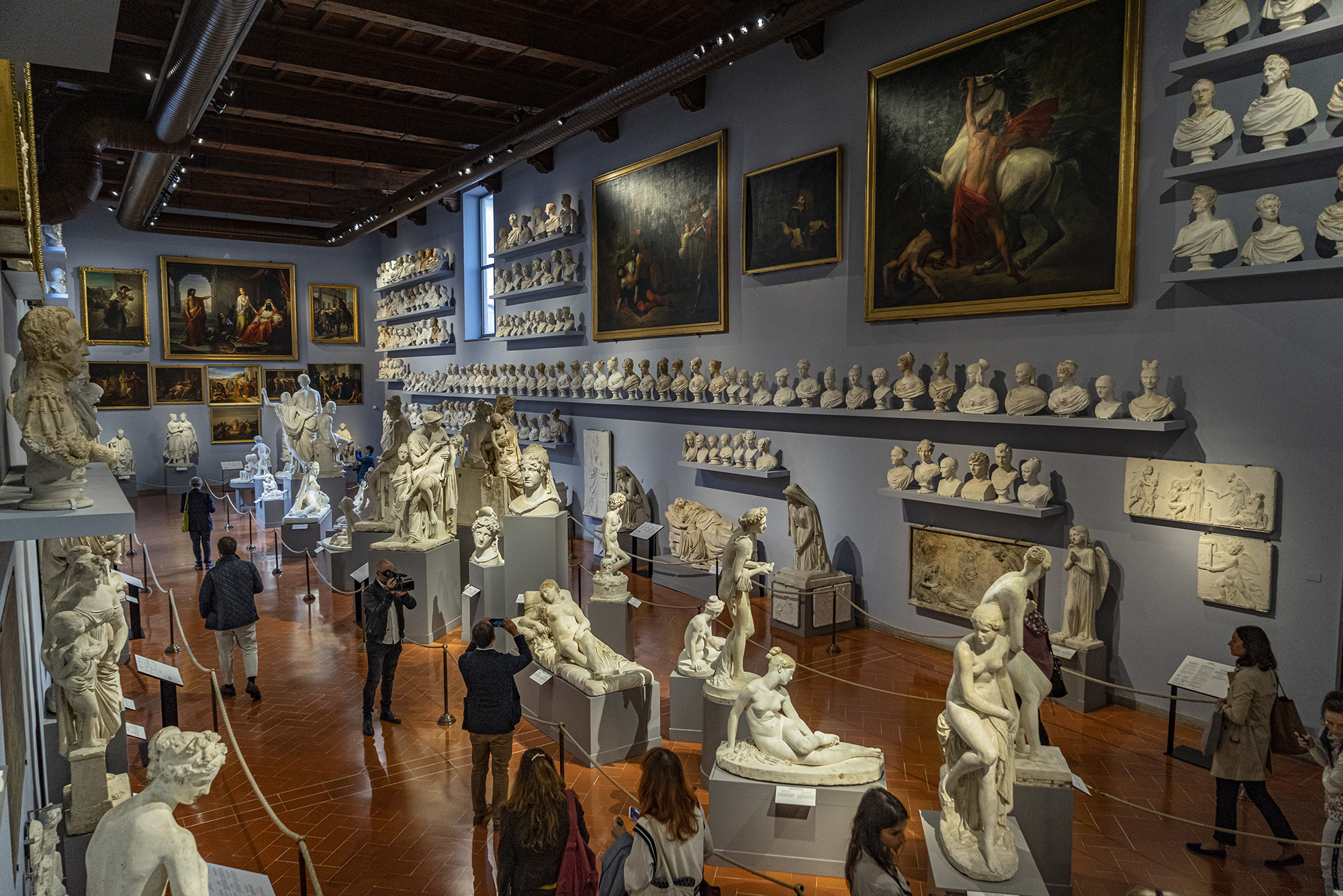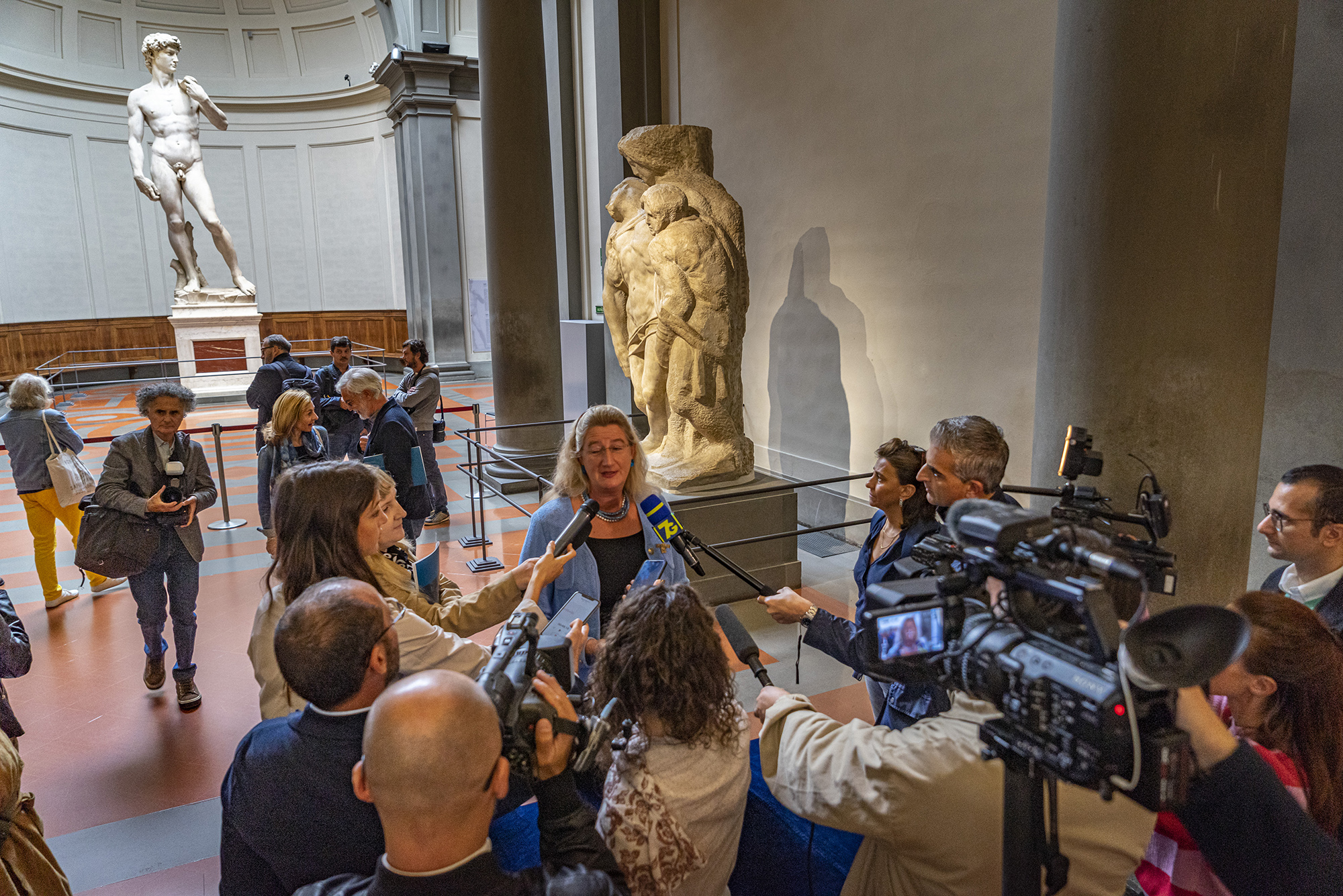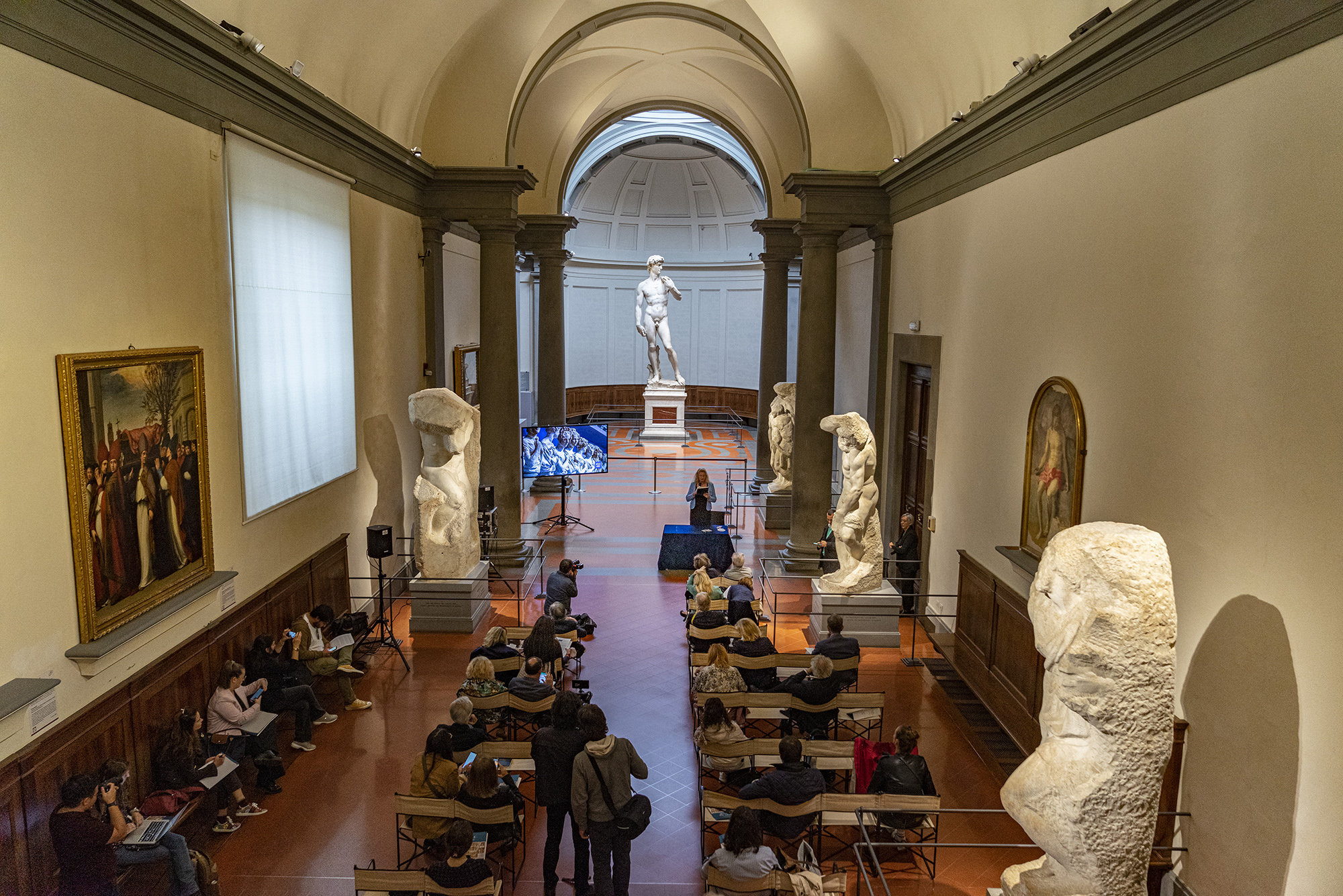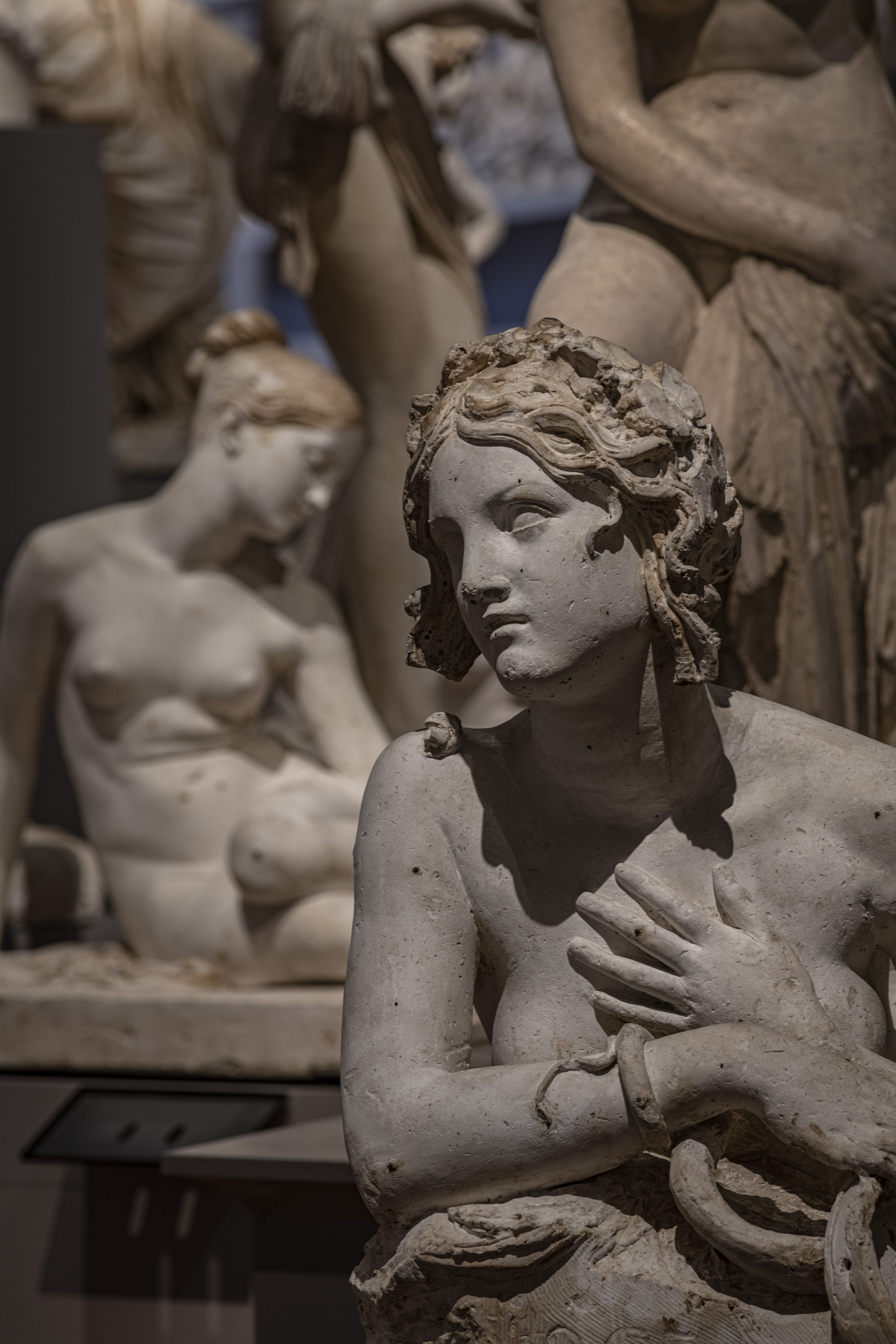Beyond the David
About This Project
La nuova Galleria dell’Accademia di Firenze
Un vero gioiello, la Gipsoteca della Galleria dell’Accademia di Firenze, che ha riaperto al pubblico lunedì 10 ottobre 2022 con una nuova veste, dopo circa due anni di lavori, che chiudono i grandi cantieri iniziati nel 2016. BEYOND THE DAVID è il titolo con cui il direttore Cecilie Hollberg presenta la nuova Galleria dell’Accademia, a sottolineare che il museo non è solo scrigno della scultura michelangiolesca, amata in tutto il mondo, ma è testimone di importanti collezioni legate all’arte fiorentina che oggi, finalmente, emergono rubando la scena persino al David.
“La Gipsoteca è l’ultimo tassello del processo di rinnovamento della Galleria dell’Accademia di Firenze” afferma con emozione Cecilie Hollberg. “Compito che mi è stato affidato dalla riforma del Ministro Franceschini, ovvero traghettare nel XXI secolo un’inedita e moderna Galleria. Un’impresa enorme che siamo riusciti a portare a termine grazie alla dedizione e alla professionalità del nostro staff e di coloro che ci hanno sostenuto. Non è stato facile ma, nonostante le tante battute di arresto, dovute alla sospensione dell’autonomia, alla crisi pandemica, alle varie criticità della struttura incontrate in corso d’opera, ce l’abbiamo fatta. L’allestimento della Gipsoteca è stato riordinato e ammodernato nel pieno rispetto di quello storico, uno degli ultimi esempi museografici rimasti di Sandra Pinto, e ringrazio Carlo Sisi per la sua preziosa consulenza. I gessi, restaurati e ripuliti, sono esaltati dal leggero azzurro polvere delle pareti, tanto da sembrare vivi. Il risultato è magnifico! Siamo orgogliosi e felici di poterlo condividere da ora con tutti.”
Il monumentale salone dell’Ottocento, già sede della corsia delle donne dell’antico ospedale di San Matteo, poi incorporato nell’Accademia di Belle Arti, raccoglie la collezione dei gessi, oltre 400, tra busti, bassorilievi, sculture monumentali, modelli originali in gran parte di Lorenzo Bartolini, uno dei più importanti scultori italiani dell’800. La collezione fu acquisita dallo Stato italiano dopo la morte dell’artista e trasferita in questa sede in seguito all’alluvione del’66. Un luogo di grande fascino che ricrea idealmente lo studio di Bartolini, arricchito da una raccolta di dipinti di maestri ottocenteschi che hanno studiato o insegnato all’Accademia di Belle Arti.
Gli interventi sono stati di ordine statico-strutturale, relativi all’impianto di climatizzazione, all’illuminazione e all’impianto elettrico. Per motivi statici e di stabilità climatica sono state chiuse varie finestre, consentendo al nuovo allestimento, con le pareti tinteggiate di color “gipsoteca”, azzurro polvere, di recuperare un ampio spazio espositivo, arricchendo la Gipsoteca anche di quei modelli in gesso che erano sinora conservati negli uffici della Galleria. Le mensole, rinnovate ed ampliate, accolgono i busti-ritratto e altri gessi di piccolo formato, che per la prima volta hanno potuto essere messi in sicurezza grazie ad un sistema d’ancoraggio sicuro e non invasivo. I modelli in gesso, nel corso dei lavori di ristrutturazione, sono stati sottoposti ad un accurato intervento di restauro conservativo e di pulitura: il gesso è un materiale estremamente delicato e fragile, il cui candore può compromettersi per ragioni diverse. E sono stati soggetti di un’accurata campagna fotografica.
I grandi cantieri sono iniziati nel 2016, includendo le fasi di studio e preparazione, generando documentazioni e planimetrie che non c’erano. Era necessario: mettere a norma l’impianto di sicurezza; rinnovare l’impiantistica; il restauro architettonico-strutturale della Gipsoteca; il consolidamento o la sostituzione delle capriate lignee settecentesche della sala del Colosso, assai trasandate; intervenire sugli impianti di areazione e di climatizzazione, mancanti in alcune sale o vecchi di 40 anni; fornire un’adeguata illuminazione. I lavori si sono sviluppati su i 3000 metri quadri del museo. Sono stati sostituiti o sanificati 750 metri di canali di areazione e rinnovati 130 metri di canalizzazioni. Per la prima volta, adesso, il museo ha un impianto di climatizzazione funzionante in ogni sala con nuove luci LED di ultima generazione che valorizzano le opere esposte e contribuiscono all’efficientamento energetico. A seconda delle necessità, sono stati fatti degli interventi su tutte le opere del museo, sono state movimentate, protette, imballate, spostate, spolverate, riviste o altro. E con l’occasione sono state realizzate campagne fotografiche approfondite, conservative o di digitalizzazione, su tutte le collezioni. Sono stati ripensati percorsi e allestimenti.
Dalla sala del Colosso, che apre il percorso espositivo con il suo blu Accademia, caratterizzata, al centro, dall’imponente Ratto delle Sabine, capolavoro del Giambologna, intorno al quale ruota la preziosa collezione della pittura fiorentina del Quattrocento e del primo Cinquecento, all’inedita sala dedicata al Quattrocento, in cui trovano una perfetta collocazione capolavori come il cosiddetto Cassone Adimari dello Scheggia e la Tebaide di Paolo Uccello, finalmente leggibili in tutti i loro meravigliosi dettagli. Dalla Galleria dei Prigioni alla Tribuna del David, fulcro del museo, con la maggiore raccolta di opere michelangiolesche che la nuova illuminazione esalta, rendendo visibile ogni particolare, ogni segno del “non finito”. Opere che si confrontano con le grandi pale d’altare del XVI e XVII secolo, che testimoniano l’influenza di Michelangelo sui suoi conterranei nella ricerca della nuova spiritualità della Controriforma. E infine le sale del Duecento e Trecento, dove i fondi oro risplendono di una luminosità mai percepita prima sulle pareti tinteggiate di un verde “Giotto”. Oggi la Galleria dell’Accademia di Firenze ha cambiato volto, ha una nuova forte identità-
The new Gallery at the Accademia in Florence
After two and a half years of work, a true gem, the Gipsoteca at the Galleria dell’Accademia in Florence reopens to the public with a new look. This completes the major reconstruction project started in 2020. BEYOND THE DAVID is the title with which the director Cecilie Hollberg presents the new Accademia Gallery, underlining that the museum is not only a treasure chest with Michelangelo’s sculptures, loved all over the world, but also testament to important collections related to Florentine art that today finally emerge, stealing the scene even from the David.
“The Gipsoteca is the last and most esteemed step in the renovation process of the Galleria dell’Accademia in Florence,” states Cecilie Hollberg with satisfaction. “A task entrusted to me by the Franceschini reform to bring from the 19th century into the 21st century an unprecedented and modern gallery. A huge undertaking that we were able to complete thanks to the heartfelt and constant commitment of our very small staff and all those who supported us. Despite the many setbacks such as the suspension of museum autonomy, the pandemic crisis, the various criticalities of the structure encountered during construction, we managed to work the miracle. The layout of the Gipsoteca has been changed and modernized in full respect of the historical context and installation, and I thank my friend Carlo Sisi for his invaluable advice. The plaster casts, restored and cleaned, are enhanced by the light powder-blue color on the walls so that they seem to spring to life with their vivacity, their stories. The result is magnificent! We are proud and happy on to be able to share it with everyone. ”
“The reopening of the Gipsoteca is an important step in the path undertaken since 2016 to bring the Accademia Gallery in Florence, one of the most important and visited Italian State museums, into the twenty-first century” declares the Minister of Culture, Dario Franceschini. “The works, concerning the entire building, have allowed significant innovations in the systems, transforming a museum conceived in the second half of the nineteenth century into a fully modern venue without distorting it. All this has been made possible by the passion, dedication and professionalism with which the director Hollberg and all the staff of the Gallery have worked since the establishment of the autonomous museum in 2015, and amid a thousand difficulties and interruptions due to the pandemic. Therefore, I wish every success to this day of celebration for the Accademia Gallery and I extend my sincere congratulations to all those who worked to achieve this important result. ”
“The Gipsoteca of the Galleria dell’Accademia – underlines Carlo Sisi, President of the Academy of Fine Arts in Florence – is an exemplary restitution, which in respecting the previous setting conceived by Sandra Pinto in the 1970s is configured as a true critical act, a museum intervention that preserves a crucial episode of national museography, renewing the compositional structure and grace of the details with methodological intelligence. The new color chosen for the walls makes it possible to recover the correct reading of the works, now exhibited in their completeness, and the removal of the obsolete air conditioning units allows you to admire the sequence of works without disturbing interruptions, now, with the ‘poetic’ continuity that can finally attract the visitor to what in the nineteenth century was called the adventure in the atelier “.
The monumental hall from the nineteenth century, formerly the women’s ward in the former hospital of San Matteo and later incorporated into the Academy of Fine Arts, brings together the plaster collection that encompasses over 400 pieces including busts, bas-reliefs, monumental sculptures, original models, many of which are by Lorenzo Bartolini, one of the most important Italian sculptors of the 19th century. The collection was acquired by the Italian State after the artist’s death and moved here following the Florence flood in 1966. The space permeates with a charm that ideally recreates Bartolini’s studio and is enriched with a collection of paintings by nineteenth-century masters who studied or taught at the Academy of Fine Arts.
The interventions were essentially static-structural in nature, focusing on the air conditioning system and lighting and electrical systems. For static and climatic stability reasons, a number of windows have been closed allowing the new installation, with the walls painted in a “gipsoteca” powder-blue color, to regain a large exhibition space and allowing the Gipsoteca to also house those plaster models that were hitherto kept in the Gallery’s administration offices. Renovated and expanded, the shelves accommodate the portrait busts that for the first time could be secured thanks to a safe and non-invasive anchoring system. During the renovation works, the fragile plaster models underwent careful conservative examinations and dusting. A detailed photographic campaign was carried out on all the works.
The major construction began in 2016 and included research and preparation phases, thus creating documentation and floor plans that had not previously existed. It was necessary: to bring the safety system up to norm, renew the engineering in the building systems, carry out the architectural-structural restoration of the Gipsoteca, consolidate or replace the dilapidated eighteenth-century wooden trusses in the Colossus Room; intervene on the ventilation and air conditioning systems, which was totally lacking in some rooms or was 40 years old in others, and to provide adequate lighting. The works expand over 3000 square meters of the museum. Seven-hundred and fifty meters of ventilation ducts have been replaced or sanitized and 130 meters of ducts have been refurbished. Now, for the first time, the museum has a functioning air conditioning system in every room with new, state-of-the art LED lights that enhance the works on display and contribute to energy efficiency. According to the needs, treatments were undertaken on all the works in the museum: they were changed, protected, packed, moved, dusted, reexamined, or other. In-depth photographic campaigns, both conservative and digitization, were carried out on all the collections. Museum routes and installations were rethought.
The Hall of the Colossus opens the exhibition route with its beautiful Accademia-blue walls, centered by the imposing Abduction of the Sabines, a masterpiece by Giambologna around which the magnificent collection of Florentine painting from the Fifteenth and early Sixteenth centuries revolves. This is followed by a new room dedicated to the Fifteenth century, housing masterpieces such as the so-called Cassone Adimari by Lo Scheggia or the Tebaide by Paolo Uccello, finally legible in all their wonderful details. The Galleria dei Prigioni to the Tribuna del David, the fulcrum of the museum, hold the largest collection of Michelangelo’s works, now enhanced by the new lighting rendering every detail and every mark on Michelangelo’s “unfinished” surfaces visible. Works are placed in context with the large altarpieces of the Sixteenth and early Seventeenth centuries, testament to Michelangelo’s influence on his fellow countrymen in their quest for the new spirituality of the Counter-Reformation. And finally, the Thirteenth and Fourteenth century rooms, where the gilded backgrounds on the paintings shine with a brightness never perceived before on the walls now painted in a “Giotto” green. Today the Galleria dell’Accademia in Florence has changed its face, it has a new strong identity.


